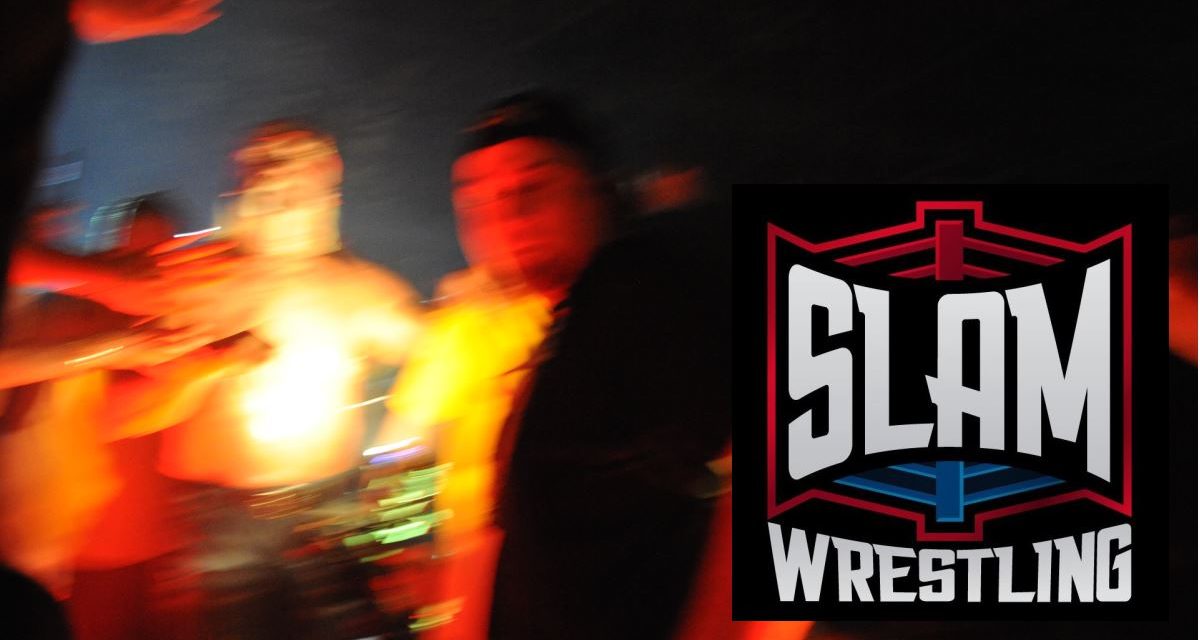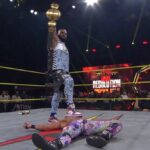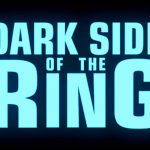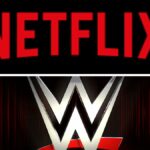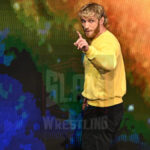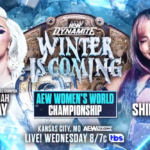With bright blue hair, face paint, half-shirt and Daisy Duke shorts, The Blue Meanie was an unmistakable character in the Land of Extreme.
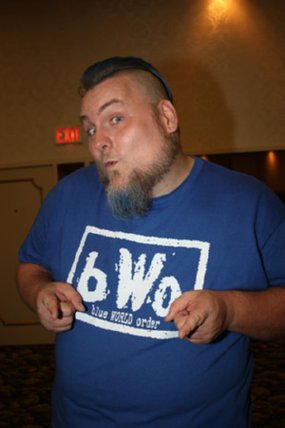
The Blue Meanie. Photo by Christine Coons.
A bizarre yet lovable character with a surprisingly perfect moonsault, the Meanie brought levity and low-brow performance art to the blood-and-guts milieu of ECW.
Alongside “Big Stevie Cool” Richards and “Hollywood” Nova, The Blue Meanie, known as “Da Blue Guy” formed the faction The Blue World Order, a parody of WCW’s New World Order. Their bWo t-shirts, mimicking the iconic nWo logo, became the best selling merch in ECW history.
That’s why WWE asked The Blue Meanie, whose real name is Brian Heffron, to co-host the new ECW Unreleased Vol. 3 DVD and Blu-ray, along with Stevie Richards and “the voice of ECW,” Joey Styles.
Now a trainer at the famous Monster Factory Pro Wrestling School in New Jersey, Heffron recently chatted at length with SLAM! Wrestling about ECW Unreleased Vol. 3, and the enduring legacy of ECW.
Here’s part two of our interview in which Heffron delves into the culture of ECW, his bucket list, how he trains aspiring young wrestlers, and why he believes he was born a decade too late.
SLAM! Wrestling: The Blue Meanie would have been a good fit with Kevin Sullivan’s bizarre Army of Darkness faction back in the ’80s, don’t you think?
Brian Heffron: Yeah, yeah, it could have been The Blue Meanie and The Purple Haze tag teaming, beating up Dusty Rhodes and Blackjack Mulligan. That would have been cool. Thinking about it now, I think The Blue Meanie would have fit in well with General Skandor Akbar’s Devastation Inc. as well, with Kamala and The Missing Link.
You know, I kind of feel like I was born a decade too late, because I think my character definitely would have been bigger in the ’80s. I probably would have gotten a bigger run in the ’80s, but just the way things worked out, it worked out perfect for me. Because, there’s times where you got a gut thing that says, you got to do this right now. I grew up in Atlantic City, and I keep showing Mrs. Meanie this spot where I turned to my mom one night as we’re walking to work. I’m saving money to become a professional wrestler, me and my mom were working in the casinos, and I saved up my tuition and I’m saving up money for living expenses, and we’re walking to work one night and I turn to her and I go, “I’m going to go into work tonight and give my two weeks’ notice. I’m going to Ohio in two weeks and start training.” I told her out of the blue. And I don’t even know what made me say those words and she goes, “Oh, okay.” And in two weeks, the day after WrestleMania 10, I’m driving from Atlantic City to Lima, Ohio.
And this is right when Al Snow started to get hot with his feud with Sabu. So I started training with Al, and he started catching on and doing this stuff with Smokey Mountain Wrestling even. Anyways, something told me now is the time, and luckily I just went with my gut instinct.
SLAM! Wrestling: There’s a match from Korakuen Hall in Tokyo between Raven and Tommy Dreamer on ECW Unreleased Vol. 3. Did you ever have an opportunity to wrestle in Japan?
Brian Heffron: No, I never made it to Japan. There’s a few places on my bucket list, though. I’d love to work at least a match in Japan or maybe a match in Australia. But I’ve done a match in Germany, and I’ve done matches in England. And I really can’t complain. I’ve wrestled in so many cool places just here in North America.
SLAM! Wrestling: Wrestling for ECW, did you have some favourite venues?
Brian Heffron: The ECW Arena was number one. Philadelphia will always be number one in my heart no matter what. Then there was the match I had at The Madhouse of Extreme at the Elks Lodge in Queens, that was just raucous. That was like being in a mosh pit because the fans are like right on top of you. It kind of reminded me of Nirvana’s “Smells Like Teen Spirit” video, where the fans are right there with the band and the fans are on top of you.
I was also fortunate to work some legendary buildings like the Hamburg Field House which was known for WWE TV back in the day, and I got to work the Ag Hall in Allentown which hosted a lot of WWE TV tapings that I watched as a child.
And then I also got to work the legendary Johnstown Arena which is the building they shot the movie Slap Shot in. Later, I got to meet the Hanson Brothers at a convention. They were kind of like they didn’t want to be bothered, they were done their signing, and they went to the bar and wanted to be left alone. They wanted their drinks and they wanted to eat their food, but I still went over and said, “Hey, I’m Brian, The Blue Meanie, pleasure to meet you. I got to wrestle in the arena where you filmed Slap Shot,” and they went, “Oh! Wow!” So that was our opening to the Hanson brothers being cool with us.
I especially enjoyed working in the Mid-Hudson Civic Centre in Poughkeepsie, where I always imitate Howard Finkel and go, “At the Mid-Hudson Civic Centre in Poughkeepsie!”
SLAM! Wrestling: There’s a wild match between Rob Van Dam and Rhino from the Mid-Hudson Civic Centre on ECW Unreleased Vol. 3.
Brian Heffron: Yeah, that’s a hard-hitting match with lots of chairs, and I believe it’s for Rob Van Dam’s ECW World Television Championship. Also in the Blu-ray extras there’s another phenomenal match for the TV title between Rob Van Dam and Jerry Lynn.
In ECW, fortunately for us, they put those matches later on in the card so we didn’t have to follow them. And you know, Rob Van Dam is one of the most respected guys in the business, but as respected as Rob Van Dam is, Jerry Lynn is held in such a high regard too because he’s another guy who kept reinventing himself. Just when you think some people would have given up, but not him.
Jerry Lynn started off in Minnesota with Sean Waltman’s crew, then they both went to Global (Wrestling Federation), then Global shut down. Then he kind of got a shot in WCW where they gave him a crappy gimmick where they just put a mask on him and gave him a name that was pretty much just his initials, Mr. J.L. But then he comes to ECW, and just like every other person who went to ECW, he was given an opportunity to reinvent himself and be himself, which is what connected him with the fans.
And then Jerry got to showcase not only his skills but his ring intelligence with the very talented Rob Van Dam, where they were putting on highlight reels each and every night. If it had been me in there with them, I would have been winded. Hell, I get winded just watching those matches. I really don’t know where they get the motor, I don’t know how they find that, as Gorilla Monsoon would say, that intestinal fortitude. But yeah, those matches were definite highlights especially when they would take it around the loop from town to town.
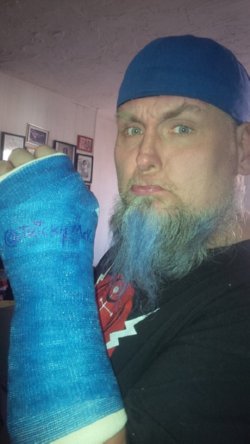
Brian Heffron shows off his cast before surgery.
SLAM! Wrestling: ECW fans were always quick to make space for the wrestlers when the action spilled into the crowd.
Brian Heffron: Our fans were pretty intelligent and they knew to get the hell out of the way. They weren’t like a Japanese crowd where if you hit them they took it as a badge of honour, where Bruiser Brody would beat the hell out of a fan and the fan would be like, thank you, thank you! Our fans said, f*** that s***, we’re gettin’ out of the way!
And ECW fans were very good at placing themselves too and knew where they should be, like the infamous match with Bam Bam Bigelow where he threw Spike Dudley into the crowd at the Arena and the crowd just picked him up and body surfed him around. Well, they tried to recreate that with Mikey Whipwreck. Mikey got thrown into the crowd one night and they went to bodysurf him and some idiot took a swing at Mikey. Well, the crowd turned on that guy, so the crowd and our security grabbed the guy by the scruff of his neck and threw him out the door. And it was kind of cool to see the crowd stick up for the wrestlers. The wrestlers are always going to stick up for the wrestlers. But in ECW, we were a lot like a hockey team. We were a lot like the team in Slap Shot.
SLAM! Wrestling: Can you shed some light on the culture of ECW’s hardcore fanbase?
Brian Heffron: ECW fans, I could tell you so many stories about how friendships were forged in the audience at ECW. I know people who met their future wives in the crowd at ECW shows. I have friendships, one of my best friends today is my friend Sebastian, I met him at my very first ECW show when I went there as a worker. We hit it off and 20-some odd years later we’re still friends today.
Just when you think you know the story of ECW, you really don’t because not only was it a culture, it was a subculture of a subculture. If you ever get a chance to see it, there’s a great documentary called Barbed Wire City by John Philapavage, where he shows the culture and subculture of ECW. At the time, it was just something that came to be through osmosis, I don’t think anybody planned it. I call ECW the Halley’s Comet of pro wrestling: it shined bright for a very short amount of time and it really had an amazing effect on us who got to see it in person. And as great as the matches are on tape, just the atmosphere of being there live was second to none.
SLAM! Wrestling: Did the atmosphere of ECW change when it went national on TNN?
Brian Heffron: ECW on TNN certainly had that different look aesthetically on television, but I would say the atmosphere at the arenas was still pretty much ECW. I remember they did a series of tapings at the Hammerstein Ballroom and they sold out back to back nights there, and that crowd was just as lively as any show I’ve ever done. When I went back in 2000, the crowd was still just as rabid as they were when I left in ’98.
SLAM! Wrestling: What did the final days of ECW feel like?
Brian Heffron: For me, it felt like I lost an old friend because I was there in the beginning as a fan, and then I was there at the end. A lot of guys were wondering what was going to happen. There were the financial problems that have been well documented, but in a lot of ways it was kind of hard to believe that the company was having financial woes when they were still drawing a lot of people. We’d go to Virginia and draw two or three thousand people and think, how is there money problems? But when you figure in the behind-the-scenes stuff of producing a national show and waiting for the pay-per-view money to come in, eventually it just burst like the Internet bubble.
SLAM! Wrestling: Would you say it was similar to the fall of Jim Crockett Promotions?
Brian Heffron: Definitely, and that’s the sin of it. If Jim Crockett Promotions never went past Chicago he’d probably still be in business today in some way or another. You got to know your limits, y’know, and try not to overextend yourself. And if ECW could have maybe just stayed regional, or syndicated where they control their ads and stuff like that, and the cost of production.
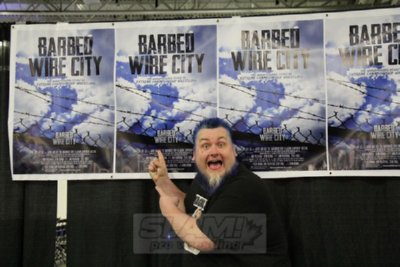
The Blue Meanie pushes Barbed Wire City in April 2013. Photo by Christine Coons.
Before ECW went to TNN it was run internally. It was a two-man operation, one guy ran the hard camera and one guy did the hand-held at ringside. Then when TNN came into being, you had a production truck and a set and all this was expected of ECW to have and flip the bill for. So maybe if they hadn’t gone for that bigger aspect of national television maybe it would have survived. Who knows. But then again towards the end you could kind of tell Paul E. was getting a little burnt out. It’s ironic you bring Jim Crockett Promotions up, though, because it was Jim Crockett who motivated Paul Heyman into becoming a promoter and a person who wanted to change the wrestling business.
SLAM! Wrestling: You too are helping evolve the business these days, training aspiring young wrestlers at The Monster Factory in New Jersey.
Brian Heffron: Yeah, I’ve been coaching at the world-famous Monster Factory for the last three years. It all came about through some extracurricular projects I had, one being an interview I did with Philly’s Nation which is a local TV show. It’s a fan-based show based around the Philadelphia Phillies and they wanted to do a wrestling themed episode where one of the hosts, Ian Riccaboni wanted to interview me in a ring and he asked, do you know a place with a ring and I said absolutely, there’s the Monster Factory over in New Jersey. So, we went to the Monster Factory, filmed it, and I just fell in love with the building. And a couple months later, I have a friend named Tommy Avallone, him and Mick Foley were doing a documentary called I Am Santa Claus, and he’s like, “I’d like to interview you with a ring in the background. Do you know a place with a ring?” And again I said absolutely, I know the guys at the world-famous Monster Factory!
So we went over there and we filmed the segment with me standing right next to the ring in the Monster Factory and I started talking to Danny Cage, the new owner, and he talked to me about possibly training there and I said absolutely, it’s something I would like to do.
SLAM! Wrestling: How many trainers are at The Monster Factory?
Brian Heffron: Pardon the pun, but I like to say The Monster Factory is a five-headed monster because there’s five different coaches, five different styles, and five different philosophies. We’re a learning tree that has so many different branches to pick from. Danny Cage, I’m trying to establish as the new owner because a lot of people still consider it Larry Sharpe’s Monster Factory. So Danny Cage was Larry Sharpe’s protégé, he was with Larry for 13 years. When he wasn’t wrestling he was talking to Larry, talking about the business, asking the right questions, and Larry taught him the ins and outs both in the ring and behind the scenes of pro wrestling.
SLAM! Wrestling: But The Monster Factory was founded by “Nature Boy” Buddy Rogers, right?
Brian Heffron: Yes, so here’s the backstory. Buddy Rogers wanted to train his son to become a professional wrestler and he liked the way Larry Sharpe had trained some of the wrestlers. A lot of people don’t know this, but, Larry Sharpe trained Kevin Von Erich, he trained King Kong Bundy, Tony Atlas, and Buddy Rogers saw that and said, “Hey, can you train my son?” So they opened up a school. Well, it got to a point where Buddy Rogers’ son didn’t want to wrestle, so Buddy Rogers hands the torch over to Larry and says, “This school is yours.”
Well, fast-forward to 2011, Danny’s with Larry and Larry’s loving the way Danny’s helping train guys and he said, “You know what, I’ve been doing this since 1983-84, I see the way you’re doing it, and I think the business would be great in your hands.” So Larry handed it over to Danny Cage. And Danny Cage is very intelligent, and wrestling-wise Danny is a great amateur wrestler, and he’s a student of where the business is going with the trends and the multimedia. He’s brought it back to the forefront, because The Monster Factory definitely had a lull period where it was down and nobody really heard much about it.
Now he’s brought it back to the forefront when it comes to wrestling schools. So Danny asked me to come along and train. So it’s myself, Danny Cage, ECW original Bill Wiles, who wrestled as Bilvis Wesley and also trained at The Monster Factory. Another wrestler, QT Marshall from Ring of Honor, he was also an amateur wrestler who also trained at The Monster Factory. And rounding out the coaches is Luis Martinez who was a student of The Monster Factory and recently had a tryout with NXT.
SLAM! Wrestling: Currently, you’re training former UFC star Matt Riddle. How’s that going?
Brian Heffron: Matt Riddle is doing phenomenal things at The Monster Factory. He’s very humble and very willing to learn and he’s a machine. And he’s listening, which is incredibly important, he’s asking the right questions. He’s worked his way up and we’ve gotten him a tryout for NXT in June. So along with Matt Riddle, I think we’ve got another four or five other guys that will probably be getting a tryout in Florida. So things are on the up-and-up with The Monster Factory.
You know, I never made a million dollars in this business but I got paid with awesome opportunities. I got to make great friendships and there’s a lot in my life I would not have if it were not for pro wrestling. So I want to pass my knowledge of what to do, and most importantly what not to do in the pro wrestling business on to these younger kids. And if I’m not in the ring and rolling around or showing them what to do, I’m talking with them and giving them examples because wrestling is just as much mental as it is physical.
I mean, every day you’re working so hard to get that 15 minutes in the ring, but there’s so much that revolves around getting that 15 minutes, from the travel, to the backstage politics, to trying not to piss off the promoter, or piss off the rest of the wrestlers. Because everybody in this business needs each other. I tell the students that everybody in this business is important from the main event to the people who tear the tickets at the door, and if I could do anything, hopefully these kids take a little piece of what I give them and pay for it down the line when they get to be around my age. This is a business I love and it’s a business that’s given me so much. I just want to give back.
SLAM! Wrestling: Lastly, we heard you recently broke your hand. How’s it healing up?
Brian Heffron: Slowly. I can barely fully open it and I can barely make a fist. It’s been a mess. I had two steel plates put in and 14 screws.
SLAM! Wrestling: That’s hardcore.
Brian Heffron: Yeah man!
The Blue Meanie urges fans to pick up the new ECW Unreleased Vol. 3, connect with him on Facebook (Brian Heffron) or visit MonsterFactory.org.
RELATED LINKS
